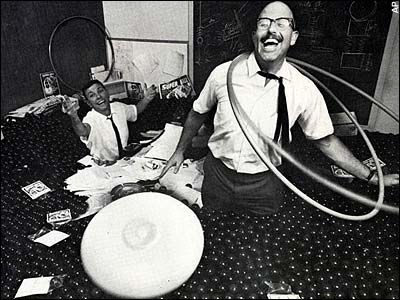I bet very few of you have heard of Arthur “Spud” Melin, but I know all of us have seen his products.
Many years ago, Spud and his boyhood friend Richard Knerr were raising falcons and training them to hunt. They made wooden slingshots to hurl meat into the air as “prey” for the birds, and crowds gathered to watch this feeding process. The two men soon realized that the slingshots—not the falcons—were what interested the spectators.
So, Spud and Knerr bought a saw from Sears (on a monthly payment plan) and went into the slingshot business. They named their company Wham-0 after the sound an object flung by a slingshot makes when it hits a target. Their quality slingshot quickly filled a niche in the marketplace that no one else even knew existed.
Then, on a trip to the beach in 1955, Spud met a guy named Fred Morrison who sold him a plastic flying disc he had made after watching Yale University students toss pie pans to each other for fun. Spud called the disc the “Pluto Platter.” By the following year, he had refined the product and renamed it the Frisbee. He rightly envisioned that the Frisbee would be more than a toy—it would become a sport.
Wham-O never sold anything conventional. Their products included a do-it-yourself bomb shelter, the Chubby Checker Limbo Set and something called the Instant Fish (all were total failures). Some of Wham-O’s toys would not be considered toys at all in today’s world. They included crossbows, pellet guns, boomerangs, daggers and those slingshots with a 100-yard range. Although much of this was unsuccessful, the company also marketed a few other products you might have purchased—the Hula Hoop, the Super Ball, Silly String and the Slip ‘N Slide.
What was behind the Wham-O executives’ keen insight into the children’s toy market? The answer is a simple one—passion. Spud was a grown man who loved toys. But persistence also was an important factor.
Much of the business community lacked the foresight and imagination to see that there was big money in Spud’s crazy ideas. Banks refused to lend the profitable Wham-O company one thin dime. When stores wouldn’t buy his toys, Wham-O sold millions of them by direct mail. In fact, over fifty banks and investors turned down Wham-O’s requests for financial backing to market the Hula Hoop. (Marketing people said it wouldn’t sell because it was “too sexy.” Toy industry executives said no one would ever be able to learn how to use it.) But Spud knew it would work. How? He always had kids test his toys to see if they had “play value.”
Long story short, after much effort and rejection, Spud finally got financing for his Hula Hoop, and Wham-O went on to sell some 25 million hoops the first year, making Spud tens of millions of dollars and making at least fifty bankers and investors sick.
“No sensation has ever swept the country like the Hula Hoop,” author Richard Johnson wrote in his book American Fads. “(It) remains the standard against which all national crazes are measured.”
The point of this story is this: Be passionate about what you do. Do your homework. And don’t give up.
Excuses are common. Persistence is rare, but it’s common in successful people. And, in my opinion, what really made Spud successful is that he would not take “no” for an answer.
